Amana 1W10287572A User Manual
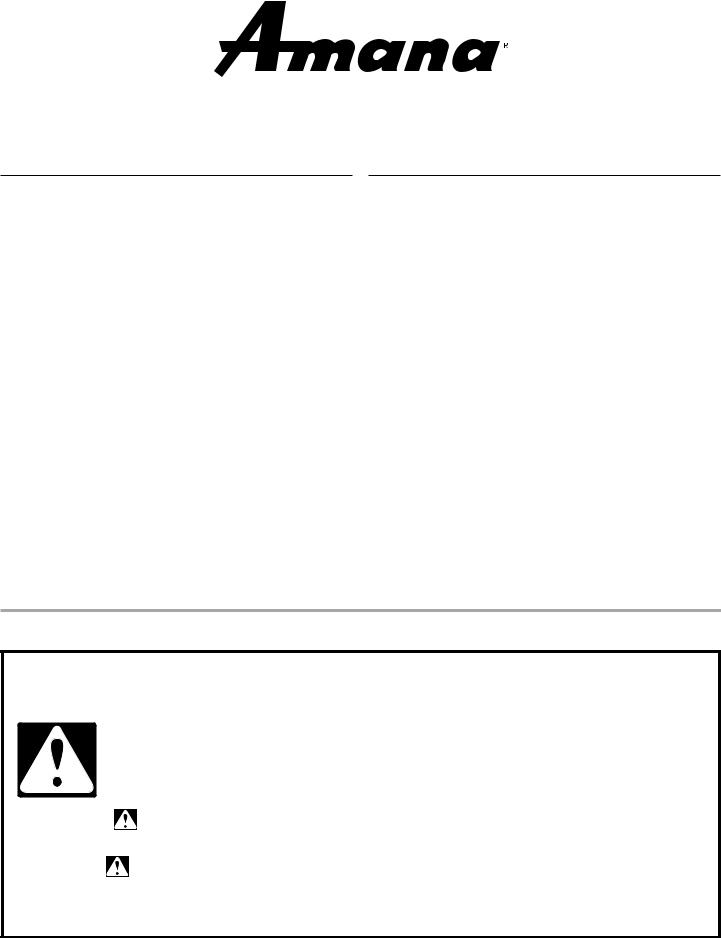
DRYER USER INSTRUCTIONS
INSTRUCTIONS POUR L'UTILISATEUR DE LA SÉCHEUSE
Table of Contents |
Table des matières |
DRYER SAFETY........................................................................ |
1 |
CONTROL PANEL..................................................................... |
4 |
CYCLE GUIDE........................................................................... |
5 |
DRYER USE.............................................................................. |
6 |
DRYER CARE............................................................................ |
7 |
TROUBLESHOOTING............................................................... |
9 |
WARRANTY............................................................................ |
11 |
ASSISTANCE OR SERVICE................................. |
Back Cover |
Keep this book and your sales slip together for future reference. You must provide proof of purchase or installation date for in-warranty service.
Write down the following information about your appliance to help you obtain assistance or service if you ever need it. You will need to know your complete model number and serial number. You can find this information on the model and serial number label, located at the top inside dryer door well.
Dealer name_ _____________________________________________
Serial number_____________________________________________
Address__________________________________________________
Phone number____________________________________________
Model number_____________________________________________
Purchase date_____________________________________________
SÉCURITÉ DE LA SÉCHEUSE............................................... |
12 |
TABLEAU DE COMMANDE.................................................... |
16 |
GUIDE DES PROGRAMMES.................................................. |
17 |
UTILISATION DE LA SÉCHEUSE........................................... |
18 |
ENTRETIEN DE LA SÉCHEUSE............................................. |
19 |
DÉPANNAGE........................................................................... |
21 |
GARANTIE............................................................................... |
23 |
ASSISTANCE OU SERVICE.............. |
COUVERTURE ARRIÈRE |
Conservez ce manuel et votre reç de vente ensemble pour référence ultérieure. Pour le service sous garantie, vous devez présenter un document prouvant la date d'achat ou d'installation.
Inscrivez les renseignements suivants au sujet de votre appareil ménager pour mieux vous aider à obtenir assistance ou service en cas de besoin. Vous devrez connaître le numéro de modèle et le numéro de série au complet. Cete information est donnée sur la plaque signalétique indiquant les numéros de modèle et de série, située dans le logement de la porte à l'intérieur de la sécheuse.
Nom du marchand_________________________________________
Numéro de série___________________________________________
Adresse___________________________________________________
Numéro de téléphone______________________________________
Numéro de modèle_ _______________________________________
Date d'achat_ _____________________________________________
DRYER SAFETY
Your safety and the safety of others are very important.
We have provided many important safety messages in this manual and on your appliance. Always read and obey all safety messages.
This is the safety alert symbol.
This symbol alerts you to potential hazards that can kill or hurt you and others.
All safety messages will follow the safety alert symbol and either the word “DANGER” or “WARNING.” These words mean:
DANGER |
You can be killed or seriously injured if you don't immediately |
|
follow instructions. |
||
|
You can be killed or seriously injured if you don't follow |
|
WARNING |
||
instructions. |
||
|
|
All safety messages will tell you what the potential hazard is, tell you how to reduce the chance of injury, and tell you what can happen if the instructions are not followed.
W10287572A |
1 |
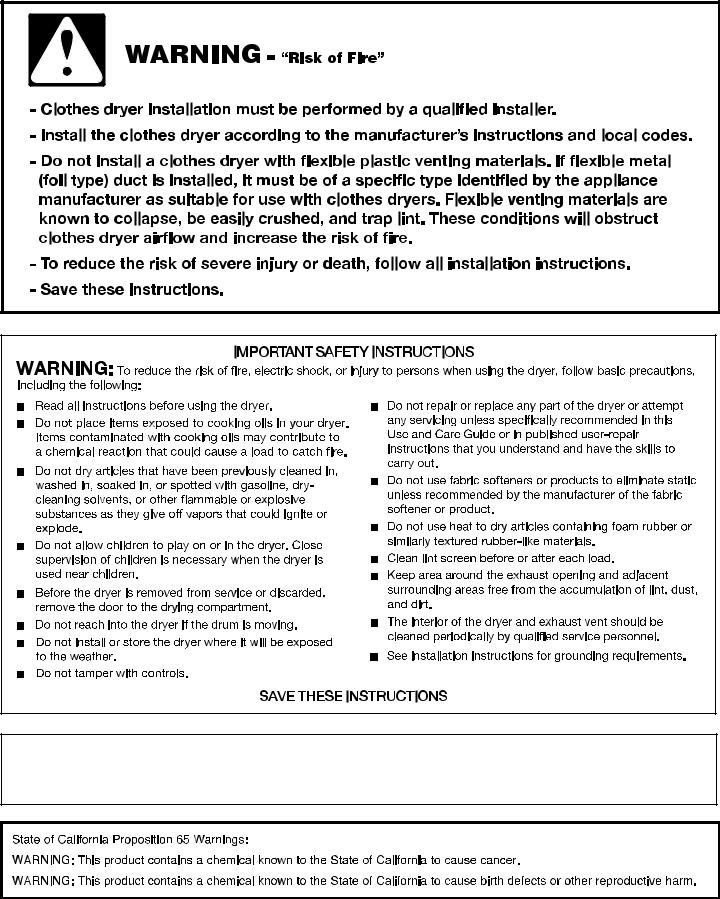
IMPORTANT: The gas installation must conform with local codes, or in the absence of local codes, with the National Fuel Gas Code, ANSI Z223.1/NFPA 54.
The dryer must be electrically grounded in accordance with local codes, or in the absence of local codes, with the National Electrical Code, ANSI/NFPA 70.
2
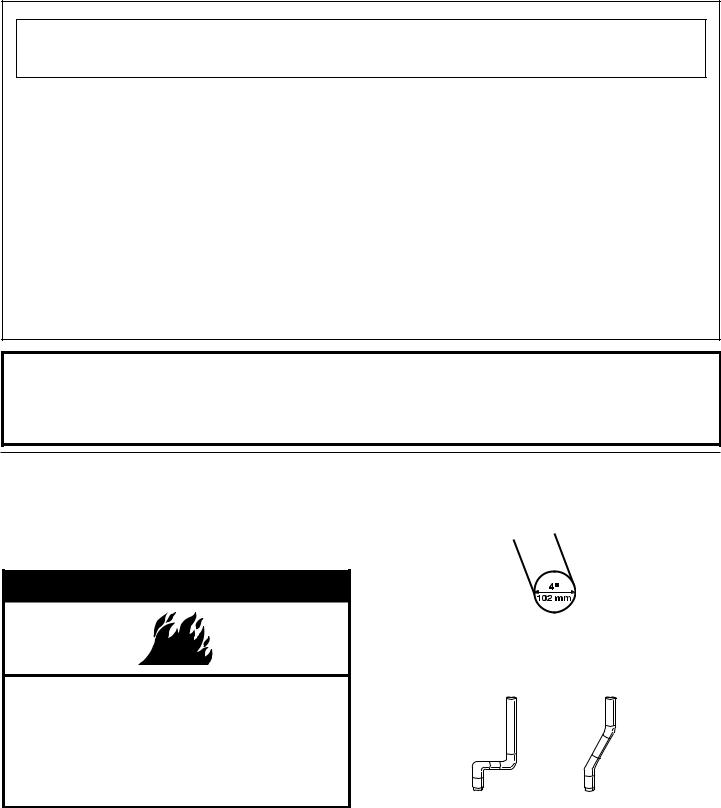
WARNING: For your safety, the information in this manual must be followed to minimize the risk of fire or explosion, or to prevent property damage, personal injury, or death.
–Do not store or use gasoline or other flammable vapors and liquids in the vicinity of this or any other appliance.
–WHAT TO DO IF YOU SMELL GAS:
•Do not try to light any appliance.
•Do not touch any electrical switch; do not use any phone in your building.
•Clear the room, building, or area of all occupants.
•Immediately call your gas supplier from a neighbor's phone. Follow the gas supplier's instructions.
•If you cannot reach your gas supplier, call the fire department.
–Installation and service must be performed by a qualified installer, service agency, or the gas supplier.
WARNING: Gas leaks cannot always be detected by smell.
Gas suppliers recommend that you use a gas detector approved by UL or CSA.
For more information, contact your gas supplier.
If a gas leak is detected, follow the “What to do if you smell gas” instructions.
Check Your Vent System for Good Air Flow
Along with heat, dryers require good air flow to efficiently dry laundry. Proper venting will reduce your drying times and improve your energy savings. See Installation Instructions.
The venting system attached to the dryer plays a big role in good air flow.
 WARNING
WARNING
Fire Hazard Use a heavy metal vent.
Do not use a plastic vent. Do not use a metal foil vent.
Failure to follow these instructions can result in death or fire.
Service calls caused by improper venting are not covered by the warranty and will be paid by the customer, regardless of who installed the dryer.
Maintain Good Air flow by:
■■ Cleaning your lint screen before each load.
■■ Replace plastic or foil vent material with 4" (102 mm) diameter heavy, rigid vent material.
■■ Use the shortest length of vent possible.
■■ Use no more than four 90° elbows in a vent system; each bend and curve reduces air flow.
Good |
Better |
■■ Remove lint and debris from the exhaust hood.
■■ Remove lint from the entire length of the vent system at least every 2 years. When cleaning is complete, be sure to follow the Installation Instructions supplied with your dryer for final product check.
■■ Clear away items from the front the dryer.
3
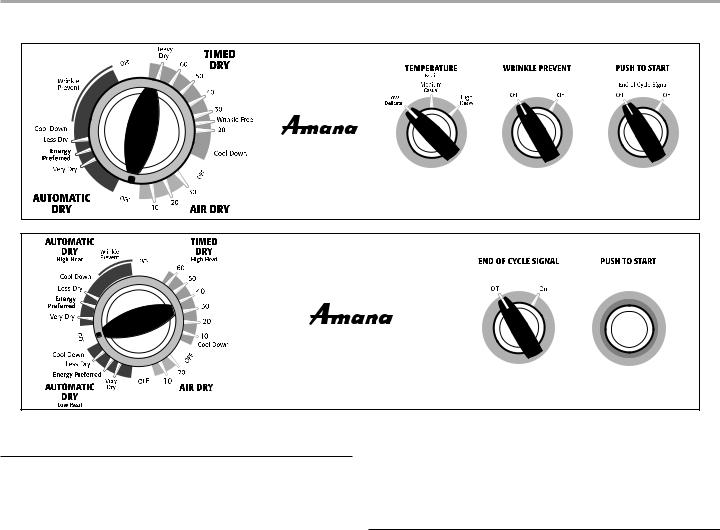
CONTROL PANEL
Not all features and options are available on all models. Appearance may vary.
Cycle Selector (Timer) Control
Automatic Dry/Sensor Dry
The Automatic dry cycle takes the guesswork out of drying time and enhances fabric care. The Automatic Dry cycle may be used for most loads.
The Cycle Selector (Timer) control may be set to ENERGY PREFERRED, which is good for most fabrics. At the end of the cycle, you may check the dryness of the load.
■■ If the load is drier than you like, select a setting closer to Less Dry the next time you dry a similar load.
Timed Dry
On some models, temperature is included in the cycle selections. On models with a selectable temperature knob, you may choose a setting based on the fabrics in your load. Drying time and temperature will depend on your dryer model.
Temperature Control
(on some models)
You may select a drying temperature based on the fabrics in your load. If you are unsure of the temperature to select for a load,
select the lower setting rather than the higher setting.
■■ If the load is not as dry as you want, select a Timed cycle to complete drying and the next time you dry a similar load, choose a setting closer to Very Dry.
Drying time with an automatic cycle varies according to the type of fabric, size of load, and temperature setting. On some models, the temperature is included in the cycle selections.
WRINKLE PREVENT Setting (on some models)
The WRINKLE PREVENT features will run after your drying cycle is complete. It periodically starts and stops the dryer, tumbling
the load without heat to help avoid wrinkling.
On some models, WRINKLE PREVENT automatically starts at the end of the cycle. Opening the door will stop this feature. On other models, you can set the WRINKLE PREVENT selector knob to ON or choose the amount of time the feature runs.
NOTE: A signal will sound periodically when the WRINKLE PREVENT setting is selected, but only if the End of Cycle signal is also selected.
Temperature Tips
If your dryer has multiple heat settings:
■■ A High heat setting may be used for drying heavyweight items such as towels and work clothes.
■■ A Low to Medium heat setting may be used for drying medium-weight items such as sheets, blouses, dresses, underwear, permanent press fabrics, and some knits.
■■ A Low heat setting may be used for drying lightweight items such as lingerie.
■■ You may use a no heat (air) setting for rubber, plastic, or heat-sensitive fabrics.
■■ Line dry bonded or laminated fabrics.
NOTE: If you have questions about drying temperatures for various loads, refer to the care label directions.
4

End of Cycle Signal Control
(on some models)
The End of Cycle signal sounds when a cycle is complete. On some models, the End of Cycle Signal is fixed. On other models, the End of Cycle Signal is selectable and the signal will sound only if set to On.
If the WRINKLE PREVENT feature is selected and the End of Cycle Signal is on, the signal sounds every few minutes. The signal stops when you open the door or turn the Cycle Control knob to Off.
CYCLE GUIDE
Not all cycles and settings are available on all models.
CYCLES |
LOAD TYPES |
FEATURES |
TEMPERATURE |
|
|
|
|
AUTOMATIC DRY or Senses moisture in the load or air temperature and shuts off when the load reaches the selected dryness SENSOR DRY level. Gives the best drying in the shortest time. Drying time varies based on fabric type, load size, and
dryness setting.
Depending on model, temperature may be selected on cycle knob or be a separate control.
Automatic Dry |
Jeans, heavy work |
Gives the best drying in the shortest time. Drying time |
High |
High Heat |
clothes, towels |
varies based on fabric type, load size, and dryness setting. |
|
|
|
|
|
Automatic Dry |
Casual, shirts, pants, |
Gives the best drying in the shortest time. Drying time |
Low |
Low Heat |
lightweight items |
varies based on fabric type, load size, and dryness setting. |
|
|
|
|
|
Towels |
Towels, Mattress |
Thoroughly dries extra-heavy items. |
High |
|
pads, quilts |
|
|
|
|
|
|
Very Dry |
Jeans, heavy work |
This dryness level removes more load moisture than the |
Any |
|
clothes |
Energy Preferred cycle. Dries heavy seams. |
|
*Energy Preferred |
Most loads |
Use this dryness level as your starting point for automatic |
Any |
Automatic Setting |
|
drying. |
|
Delicates |
Small loads, |
Gently dries delicate items. |
Low or Extra Low |
|
lightweight items |
|
|
|
|
|
|
Less Dry |
Most loads |
This dryness level removes less moisture than the Energy |
Any |
|
|
Preferred cycle. Seams of garment may feel slightly damp. |
|
|
|
Use for loads you may want to complete drying on a |
|
|
|
hanger. |
|
TIMED DRY |
Will run the dryer for the specified time on the control. |
|
|
Depending on model, temperature may be selected on cycle knob or be a separate control.
Timed Dry |
Heavy or bulky items |
Completes drying if items are still damp. |
High |
High Heat |
|
|
|
|
|
|
|
Timed Dry |
Small loads, |
Gently dries delicate items and knits. |
Low |
Low Heat |
lightweight items |
|
|
|
|
|
|
Heavy Dry |
Large or heavy items |
Evenly dries large or heavy loads. |
High |
|
such as thick towels |
|
|
|
or robes |
|
|
|
|
|
|
Damp Dry |
Any load |
Dries items to a damp level or for items that do not require |
Any |
|
|
an entire drying cycle. |
|
Wrinkle Free |
Any load |
Helps smooth out wrinkles, such as those found in clothes |
Low or Medium |
|
|
packed in a suitcase or in items wrinkled from being left in |
heat depending on |
|
|
the dryer too long. |
fabrics in load |
Air Dry |
Rubber, plastic, heat |
No-heat drying. |
No heat |
|
sensitive fabrics |
|
|
|
|
|
|
SPECIAL SETTINGS |
These settings are added at the end of certain cycles to reduce wrinkling. |
|
|
|
|
|
|
Cool Down |
All loads |
This is the last step in a cycle that uses heat. The load is |
No heat |
|
|
cooled slowly to reduce wrinkling and make it easier to |
|
|
|
handle. |
|
Wrinkle Prevent |
Any load |
*Periodically starts and stops dryer, tumbling the load |
No heat |
|
|
to avoid wrinkling. |
|
|
|
|
|
*On some models, the dryer continuously tumbles the load, without heat, for up to 30 minutes or until the dryer door is opened.
5
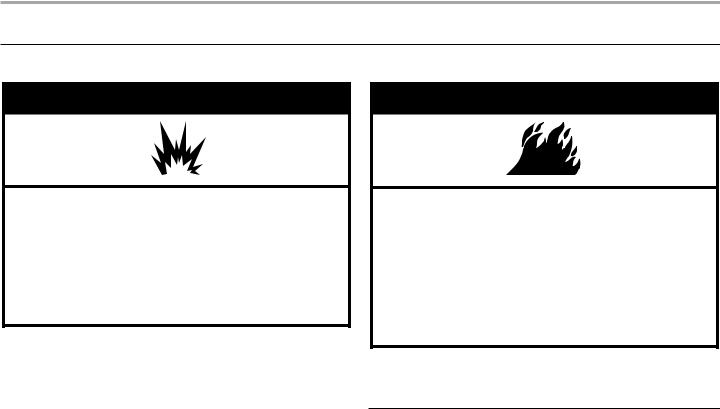
DRYER USE
Starting Your Dryer
 WARNING
WARNING
Explosion Hazard
Keep flammable materials and vapors, such as gasoline, away from dryer.
Do not dry anything that has ever had anything flammable on it (even after washing).
Failure to follow these instructions can result in death, explosion, or fire.
WARNING: To reduce the risk of fire, electric shock, or injury to persons, read the IMPORTANT SAFETY INSTRUCTIONS before operating this dryer.
This guide covers several different models. Your dryer may not have all of the cycles and features described.
Before using your dryer, wipe the dryer drum with a damp cloth to remove dust from storing and shipping.
1.Clean lint screen before each load. See “Cleaning the Lint Screen.”
2.Load clothes loosely into the dryer and close the door. Do not pack the dryer. For best results, allow space for clothes to tumble freely.
3.Turn the Cycle Control knob to the recommended cycle for the type of load being dried. Use the Energy Preferred Automatic Setting to dry most heavy to medium-weight fabrics.
4.If your dryer has a Temperature selector, set it to the recommended setting for the type of fabric being dried. See “Cycle Guide” for temperature suggestions. On some models, temperature is included in the cycle selections.
5.(OPTIONAL) Your dryer may have a Wrinkle Prevent feature selector. Use this to avoid wrinkling when you are unable to remove a load from the dryer as soon as it stops.
6.(OPTIONAL) Your dryer may have an End of Cycle Signal. The signal is helpful when drying items that should be removed from the dryer as soon as it stops.
The End of Cycle signal is part of the Start button and is selectable. Turn the Start button to ON or OFF. The signal will sound only if the selector is set to On.
7.If desired, add fabric softener sheet. Follow package instructions.
8.Push the Start button or knob.
Stopping and Restarting
You can stop your dryer anytime during a cycle.
To stop your dryer
Open the dryer door or turn the Cycle Control knob to OFF.
NOTE: The Cycle Control knob should point to an Off area when the dryer is not in use.
 WARNING
WARNING
Fire Hazard
No washer can completely remove oil.
Do not dry anything that has ever had any type of oil on it (including cooking oils).
Items containing foam, rubber, or plastic must be dried on a clothesline or by using an Air Cycle.
Failure to follow these instructions can result in death or fire.
To restart your dryer
Close the door. Select a new cycle and temperature (if desired). Push the Start button or knob.
Drying Rack
(Optional on some models)
Use the Drying Rack to dry items such as sweaters and pillows without tumbling. The drum turns, but the drying rack does not move.
If your model does not have a drying rack, you may be able to purchase one for your model. To find out whether your model allows drying rack usage and for information on ordering, please refer to the front page of the manual or contact the dealer from whom you purchased your dryer.
NOTE: The drying rack must be removed for normal tumbling.
To use the drying rack
1.Place drying rack in dryer.
Slide rear pegs into the dimples on the back wall of the dryer. Lower the front legs to rest on the dryer opening.
2.Put wet items on top of drying rack, leaving space between items. Do not allow items to hang over the edge of the drying rack. Close the door.
3.Select a Timed Dry cycle and temperature, or an air cycle. Items containing foam, rubber, or plastic must be dried on a clothesline or by using an air cycle. Refer to the following table.
4.Start the dryer. Reset cycle to complete drying, if needed.
Rack Dry |
Cycle |
Temp |
Time |
Washable wool items |
Timed |
Low |
60 min. |
(block to shape, lay flat |
Dry |
|
|
on drying rack) |
|
|
|
|
|
|
|
Stuffed toys/pillows |
Timed |
Low |
60 min. |
(cotton or polyester filled) |
Dry |
|
|
|
|
|
|
Stuffed toys/pillows |
Air |
N/A |
90 min. |
(foam rubber filled) |
(no heat) |
|
|
6
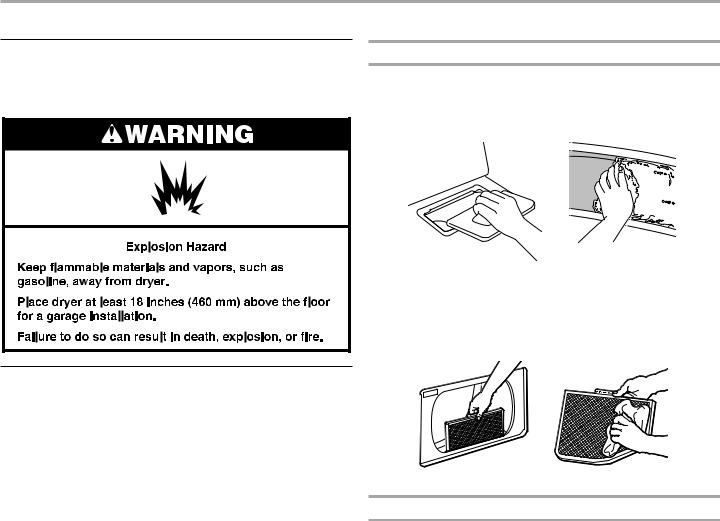
DRYER CARE
Cleaning the Dryer Location
Keep dryer area clear and free from items that would block the air flow for proper dryer operation. This includes clearing piles of laundry in front of the dryer.
Cleaning the Lint Screen
Clean lint screen before each load. A screen blocked by lint can increase drying time.
IMPORTANT:
■■ Do not run the dryer with the lint screen loose, damaged, blocked, or missing. Doing so can cause overheating and damage to both the dryer and fabrics.
■■ If lint falls off the screen into the dryer during removal, check the exhaust hood and remove the lint. The exhaust hood is located where the dryer air exits your home.
Every Load Cleaning
Style 1:
1.The lint screen is located on top of the dryer. Pull the lint screen toward you. Roll lint off the screen with your fingers. Do not rinse or wash screen to remove lint. Wet lint is hard to remove.
2. Push the lint screen firmly back into place.
Style 2:
1.The lint screen is located in the door of the dryer. Pull the lint screen straight up. Roll lint off the screen with your fingers. Do not rinse or wash screen to remove lint. Wet lint is hard to remove.
2. Push the lint screen firmly back into place.
As Needed Cleaning
1.Roll lint off the screen with your fingers.
2.Wet both sides of lint screen with hot water.
3.Wet a nylon brush with hot water and liquid detergent. Scrub lint screen with the brush to remove residue buildup.
4.Rinse screen with hot water.
5.Thoroughly dry lint screen with a clean towel. Replace screen in dryer.
7
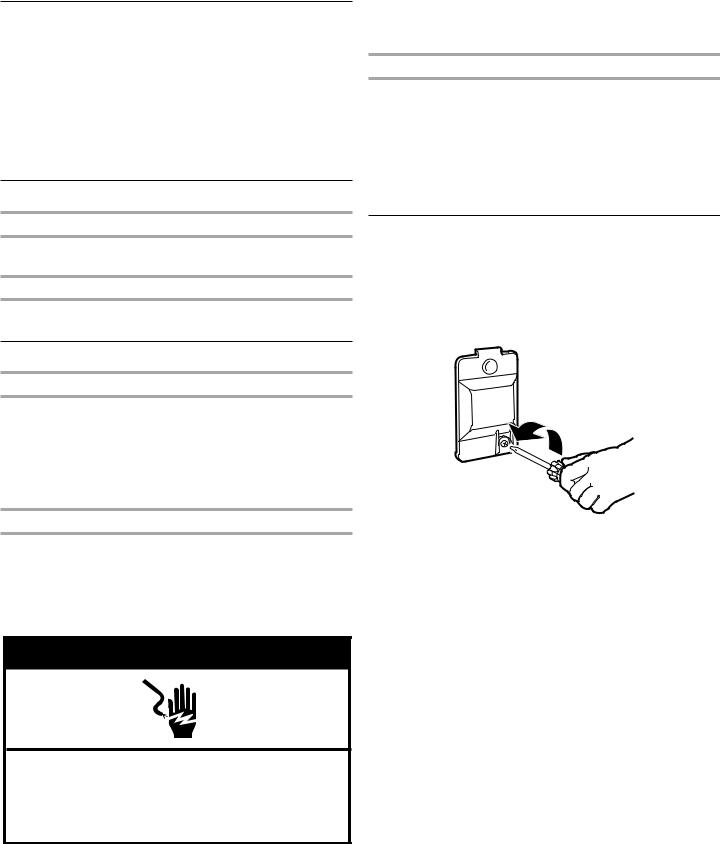
Cleaning the Dryer Interior
1.Apply a liquid, nonflammable household cleaner to the stained area of the drum and rub with a soft cloth until stain is removed.
2.Wipe drum thoroughly with a damp cloth.
3.Tumble a load of clean cloths or towels to dry the drum.
NOTE: Garments that contain loose dyes, such as denim blue jeans or brightly colored cotton items, may discolor the dryer interior. These stains are not harmful to your dryer and will not stain future loads of clothes. Dry these items inside out to avoid drum staining.
Removing Lint
From Inside the Dryer Cabinet
Lint should be removed every 2 years, or more often, depending on dryer usage. Cleaning should be done by a qualified servicer.
From Inside the Exhaust Vent
Lint should be removed every 2 years, or more often, depending on dryer usage.
2.Disconnect wiring.
3.Make sure leveling legs are secure in dryer base.
4.Use masking tape to secure dryer door.
Moving care - Gas Dryers
1.Unplug the power supply cord.
2.Close shutoff valve in gas supply line.
3.Disconnect gas supply line pipe and remove fittings attached to dryer pipe.
4.Cap the open fuel supply line.
5. Make sure leveling legs are secure in dryer base.
6.Use masking tape to secure dryer door.
Changing the Drum Light
(on some models)
1.Unplug dryer or disconnect power.
2.Open the dryer door. Locate the light bulb cover on the back wall of the dryer. Using a Phillips head screw driver, remove the screw located in the lower right-hand corner of the cover. Remove the cover.
Vacation and Moving Care
Vacation Care
Operate your dryer only when you are at home. If you will be on vacation or not using your dryer for an extended period of time, you should:
1.Unplug dryer or disconnect power.
2.If you have a gas dryer, close shutoff valve in gas supply line.
3.Clean lint screen. See “Cleaning the Lint Screen.”
Moving care - Electric Dryers
For power supply cord-connected dryers:
1.Unplug the power supply cord.
2.Make sure leveling legs are secure in dryer base.
3.Use masking tape to secure dryer door.
For direct-wired dryers:
 WARNING
WARNING
Electrical Shock Hazard Disconnect power before servicing.
Replace all parts and panels before operating.
Failure to do so can result in death or electrical shock.
1. Disconnect power.
3.Turn bulb counterclockwise. Replace the bulb with
a 10-watt appliance bulb only. Replace the cover and secure with the screw.
4.Plug in dryer or reconnect power.
8
